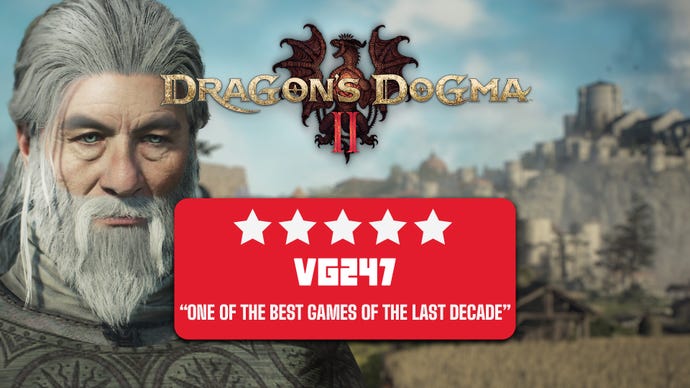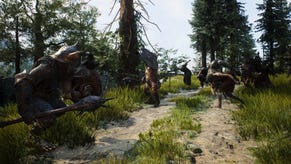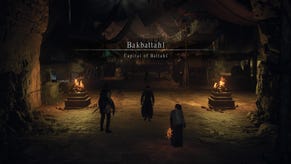Dragon’s Dogma 2 review: one of the greatest games of all time… if you’ve the right constitution
Capcom's 12-year vision comes to life in a leap that's comparable to the jump FromSoft made from Demon's Souls to Dark Souls 3. Yes, really.
Dragon’s Dogma 2 is uncompromising.
It took me a long time to settle on a single word that I could use to describe this curious role-playing game. Even stretching beyond a word, Dragon’s Dogma 2 practically defies easy definition. There’s a huge laundry list of games that it is a little bit like, but few that it is actually really similar to - so that shorthand is ineffective.
In the good old days, Capcom’s marketing department would’ve briefed that Dragon’s Dogma is so unique that it renders traditional genre names obsolete. We’d be getting press releases telling us that it isn’t just an action-RPG, but instead is something like a ‘Full Action Reactive World RPG’, or some nonsense like that.
Short of that, however, uncompromising is a pretty good way to describe it. Here’s another: it’s one of the best games of the last decade.
That’s a big statement, but let’s row back for a moment to that one-word descriptor. In a design sense, Dragon’s Dogma 2 is a game that does not flinch. It’s hardcore, it’s serious. It’s real stuff. Full-fat. It’s the sort of game that’ll put hair on your chest.
Exactly how it accomplishes this is difficult to sum up. It’s more about a vibe, a feeling. But it can be communicated with examples. Take the nighttime, for instance. Late hours in games are often visually different, but not really truly that dark. Plus, we all set those brightness sliders a little bit brighter than we should, don’t we? But in Dragon’s Dogma 2, even if you do that, the night is pitch black and dangerous-feeling. You can’t see more than a few feet in front of you, even with a lantern equipped. Dank caves are thick with danger in the oppressive dark. Outside isn’t much better. It’s wonderful.
Fast travel is rare, and requires an item that is expensive and difficult to acquire. You’re encouraged to manually travel around, which gives you a muscle memory of the game’s world that is seldom delivered in modern open-world games. There’s a single save slot – not through incompetence but by design. The developers want you to weigh the consequences and live with your actions. If you make a choice in a side quest that sees people turn against you or die, the game quickly auto saves - you live with it, idiot. You made the choice.
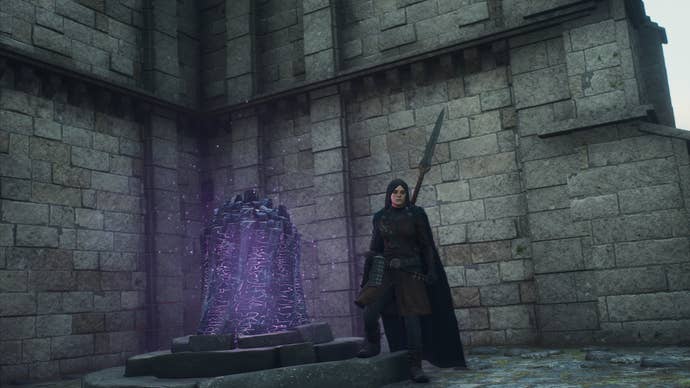
Quests will frequently tell you to speak to certain people, but do so without offering a waypoint or a checkpoint list of who to interrogate; you’re instead encouraged to explore and find the information you need more organically. The quest design, which is significantly improved over the first game, generally requires you to use your noggin.
One main story mission has you searching a character’s quarters for incriminating evidence. As it turns out he has a hidden room for undertaking nefarious deeds behind a false wall - but the wall isn’t waypointed, and can only be spotted when you look very closely. The intention is that you fully immerse and truly search the room, not just stomp to a waypoint and press a button in front of a glowing item.
Or, like - helmets. This is a weird one to bring up, right? But a lot of RPGs chicken out on the helmet issue. That is to say - helmets are important gear, but most games feature a setting to visually turn helmets off so you can see your created character’s pretty face while retaining the stat boost. Not so in Dragon’s Dogma 2. If you want the stats, you deal with the visual - the same for all of your gear. Visors can be flipped up, but that’s it. I’m a helmet hater, so I had to spend most of the game forgoing the stat boost headgear would give - and I made my peace with that. Dragon’s Dogma 2 does not compromise its world for easy convenience.

That isn’t to say this is an inconvenient experience, however - far from it. The first Dragon’s Dogma had the exact sort of teething issues you’d expect from a team taking its first run at an open-world RPG, and this sequel goes to great lengths to address fan feedback and make the experience more frictionless. Oxcarts are a good example of this - a more accessible fast travel variant that lets you either enjoy a leisurely real-time ride in a carriage or press a button to doze off and skip through the journey.
But Oxcarts only take set routes along relatively safe roads, only in the daytime, and even then can be ambushed by enemies, interrupting the ride, at random. You always have to be ready to fight. Teleportation is still expensive and rare, but in Oxcarts there is now another fast travel option - albeit one that doesn’t compromise with the unflinching nuts-and-bolts role-playing vision. They’re even a useful tool of discovery - since they travel set routes, you can hop on an Oxcart and let it take you to places you’ve never been before, like jumping on a random bus in the real world and seeing where it ends up. Oxcarts are handy, but crucially they also feel true and honest to the world.
Spinning a Yarn
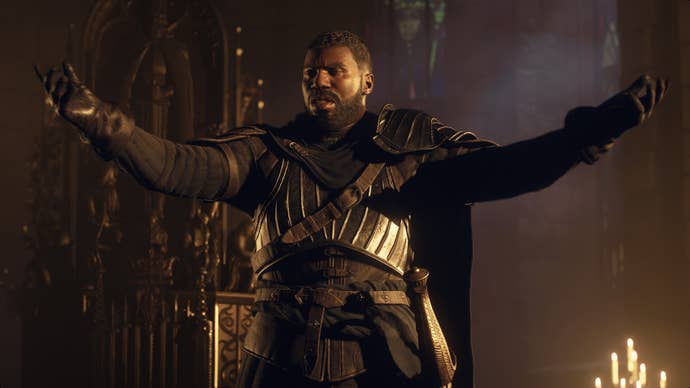
The best way to get across this sense of role-playing is to tell you a story. After just two or three story missions, you’re cast out into the game’s significant open world. From that early point on, you’re free to roam. There’s two larger kingdoms, complete with sprawling capitals and smaller hamlets, plus a smaller independent state hiding away in some of the furthest reaches. There are ruins, caves, and distractions aplenty. While you can return to a particular NPC and keep getting story quests to advance the narrative, you honestly don’t have much call to. Urgency doesn’t set in until later in the story; you are invited to noodle.
Noodle I did, and so one of the first things I decided to try to do was to leave the country where the story gets going, Vermund, and travel to Battahl, the other major nation in the narrative. I hitched a ride to a border town where I discovered a checkpoint between the two nations, guards requesting paperwork and all. I didn’t have any paperwork, obviously - that’s obtained by progressing the story. After a few more elaborate attempts to bypass the border gate, I got lucky - somebody else came who did have the paperwork, their ox-drawn cart breezing through the border. I hopped onto the back of their cart and quietly rode it through the border as a stowaway.
I hadn’t thought it all through, really. As the border gate slammed closed behind me, with no paperwork to make a return trip, I found myself in a higher-level area of the game extremely early on. At the time I didn't have any of the rare fast travel teleportation items on me. I had no option other than to go forward, deeper into the dangerous zone in search of a way back to more level-appropriate areas. I didn’t know for sure where the nearest town would even be to rest, strategize, or try to buy a fast travel item - and I could tell by scanning the horizon that it was probably going to be at least a two-day trek on the in-game clock, which would mean traveling in the oppressive dark of night where this dangerous area would become even more so.
I only had a single camping kit, so I only had one in-the-field heal - and camping can be raided by roaming enemies, if you’re unlucky. Suddenly Dragon’s Dogma 2 offered up a few hours of not breezy RPG adventuring, but a brutal struggle for survival.
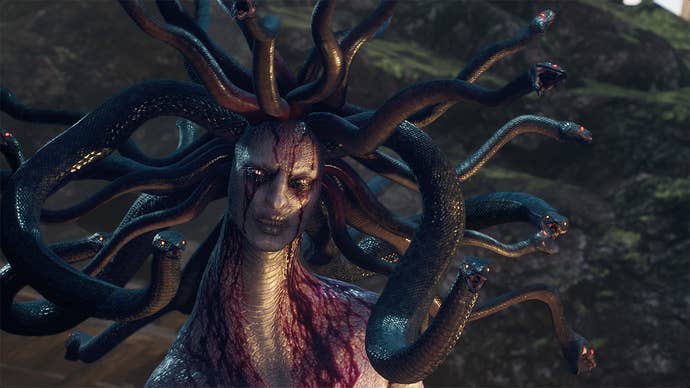
This was a Dark Souls of my own making; my explorative hubris landing me in extremely hot water. When people inevitably compare this game to FromSoftware’s Souls games, this is what they’re getting at. The combat doesn’t have the steady-footed pace of those games, and the story is delivered in a more straightforward way (though there is hidden nuance and depth to be enjoyed if you so desire). With that said, there’s a similar vibe that cannot be denied. Traveling this world, especially early on, and at night, features that same glorious sphincter-tightening dread at what might be around the corner.
A key inspiration for the first Dragon’s Dogma was Fallout 3 and Oblivion, but it’s in this sort of thing that it truly differentiates its open world exploration, too. In those games, you create a million save files and roll back if something goes wrong. If you venture into a high-level area, some punk one-shots you and that’s that; you load a save and turn around. Dragon’s Dogma is in your face with a single save slot and an aggressive auto save that absolutely wants to document your silly mistakes. Exploring feels less like busywork filling in a map, and more like truly taking your life into your own hands.
In the end, I escaped Battahl and returned to Vermund, confining my exploration to its green and verdant lands for a good 20 hours before crossing the border again. But that adventure is seared into my brain as one of those truly sublime video game moments. The joy and fear of feeling like I’d broken it, like I’d potentially ruined my save, was genuinely fabulous. When I finally secured my exit strategy, I felt like the biggest genius to ever live.
And of course, Dragon’s Dogma 2 is designed quite carefully - so no matter how hopeless things feel, there is always a way out. You may just have to think long and hard. If you really can’t crack it, the nuclear option is to ask the game to roll you back to your last Inn Rest, which is always guaranteed to be safe. But if you don’t rest at an inn regularly, you could lose an hour or two of progress. Then again, with how health works in this game, regular and proper rest stops are utterly vital.
.png?width=690&quality=70&format=jpg&auto=webp)
From this story alone, you can probably judge exactly how you’ll feel about Dragon’s Dogma’s structure. This isn’t a game that’ll challenge you with particularly difficult boss or enemy encounters, for instance. Combat is challenging but not difficult, if you know what I mean. The nature of battles as a party-driven affair, your protagonist supported by AI buddies, means there’s most often someone there to bail you out when things get rough.
Instead, Dragon’s Dogma 2 offers difficulty in how you get to those combat encounters and in how they interface with an unpredictable living world. Traveling the world safely, without eventually being overwhelmed by a series of combat encounters that individually aren’t too trying but in succession become more frightening, is a key wrinkle. So, too, is the very real fear that the world could just procedurally throw a nightmare curveball your way.
For much of the game, the shadow of a griffin soaring over your head high above is a terrifying sight - for you’ll be fearful of it swooping down to join you on the ground. I had oxcart journeys that were intended to be stress-free fast travel interrupted by raiding enemies - but then in the ensuing fight, I saw the cart itself get smashed to bits, leaving us in the middle of nowhere in the dead of night. Crucially, none of that is scripted - it just sort of happens from time to time as various monster and world AI routines collide.
Pawn Stars

Dragon’s Dogma 2’s AI can’t be mentioned without getting into the pawns - the series’ most recognizable hallmark. If you didn’t play the original, the concept is simple enough - as well as a protagonist, you create a ‘main pawn’, a not-quite-human being that is basically - perhaps slightly uncomfortably - your slave. But it’s a benevolent relationship; they love you and exist to serve. The tale of Dragon’s Dogma is inherently a multiversal affair - and you can reach beyond your world to recruit two more pawns from afar - making for a party of four. The twist is that any pawns you recruit, if you’ve an at least intermittent online connection, will be the main pawns of other players, visiting you.
Pawns carry knowledge from all of their adventures with them. So if you’re stuck on a particular quest, you could hop to a Riftstone Portal and deliberately recruit a pawn whose master has already completed that quest. That pawn would offer up their knowledge - where to go, who to talk to, what to do. If you encounter a new type of enemy that you’ve not defeated before, a pawn who has seen it all elsewhere might offer verbal advice on how to hit its weak points and take it down more effectively. Pawns have unique personalities and are influenced not just by the actions of their master, but also of the pawns and protagonists they travel with in other worlds.
To hear Dragon’s Dogma director Hideaki Itsuno tell it, the aim is to give the feeling of playing the game alongside someone else who has perhaps played it all before - who can give you a guiding hand. Much effort has been put into the pawns this time, and the illusion is moderately better - but still a little janky. It remains obviously an AI facsimile of a real living companion. Itsuno’s stated goal of pawns feeling like a real person hasn’t been met just yet. But it’s better than in the first game - and more generally, they just work, jank and all.
.jpg?width=690&quality=70&format=jpg&auto=webp)
Sure, they repeat themselves a little too often. I wish there were more variety in both the voice lines and the delivery (given this sprawling game is 61GB, they could probably easily double the number of audio files and still maintain a reasonable install size). But… I’m attached to Eloise, my pawn. She’s funny. She’s helpful. Every now and then, she pulls out a trick or a line of dialogue that genuinely surprises me. On more than a few occasions, her actions have directly saved my Arisen’s life, dragging my immobilized form out of the path of a killing blow or catching me from what would’ve been a fatal fall. And on the few occasions when the game’s narrative separates me from her for more than a few moments… I feel weirdly vulnerable without her. The system works.
There are fascinating elements of the pawn system I’ve barely seen, too. I managed to get through 80 hours with the game without my pawn contracting a debilitating, personality-altering disease that’s actually contagious and travels from one pawn to another. But even knowledge of that system is thrilling: during the review period, I was in a group chat with other media who were starkly warning not to recruit certain pawns. One YouTuber’s pawn was warned off as persona-non-grata because it had the disease. This stuff is going to be a glorious minefield once it’s more than a handful of critics playing the game.
Vocational Hazard
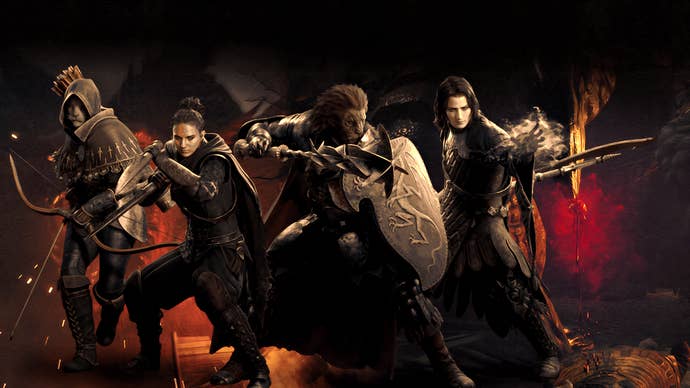
In fact, something that you have to accept with this game is an inability to see everything - at least, not in a single run. That automatic saving element is a part of it, for one. Characters are going to get downed, events are going to transpire, and doors to potential quests and storylines will slam shut in front of you. But that’s sort of the point - it’s part of the fun, part of the design. There’s also a hell of a lot of the game that you can simply not see if you’re not aggressive enough in exploration.
For instance, I didn’t uncover a major side quest involving a puzzling beast until the very end of the game - but I could’ve found it right at the start. There was an entire major town I didn’t touch at all. And the vocations - the ‘job system’ at the heart of Dragon’s Dogma’s RPG combat - I ultimately only used around half of the options. In subsequent playthroughs, I’ll get to grips with the rest.
The core team behind this game worked on Devil May Cry 5, and while it’s reaching, the best way to describe this combat is probably to say it’s a bit like the speedy, combo-heavy, and SS-Stylish combat of DMC had a love child with the scrappier, party-driven battles of Monster Hunter.
Where Dragon’s Dogma sets itself apart from those games is in how it makes use of traditional RPG weapon and ability tropes in interesting ways, with each vocation offering a little twist of some sort on classics like Warrior, Fighter, and Archer. As more advanced classes unlock, so too do more intricate and exciting move sets - my favorite so far being the Mystic Spearhand, a combination of Polearm attacks and enemy-manipulating magicks.
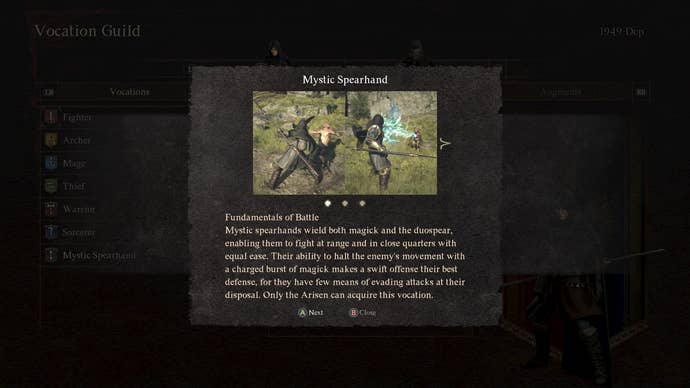
Party composition is important, so switching both your class and abilities plus those of your main pawn is key. Then you recruit two more pawns to fill the gaps in your skill set. The same is true of gear - you’ll be constantly thinking about who can do what, making sure you’re able to cover all the bases in any combat encounter the game might throw at you. If your squad has a specific shortcoming, your pawns might even verbally flag it up to you by way of warning.
It’s all just a little bit brilliant, in honesty. This combat isn’t perhaps as deep as some other games, but it’s deeply satisfying to just experiment with all the wild combinations on offer. Smaller mobs somewhat become target practice, letting you figure out stuff that then will need to be deployed on the larger, more threatening enemies. Naturally, the series tradition of clambering all over gigantic foes remains intact - and actually gets amped up to its largest degree yet later in the game.
Balance and Ruin
.png?width=690&quality=70&format=jpg&auto=webp)
The balance of it all is difficult to fully describe, in the end. Souls, for instance, is all about combat. Many of us love the lore and the atmosphere too, of course - but those diamond-solid fights are its raison d'être. And to stick with the comparisons we used earlier, things like Elder Scrolls are arguably more about the world vibe - exploring, messing around, the combat sort of a secondary concern. Dragon’s Dogma splits the difference; it’s all about that world and its AI constantly turning in on itself, twisting, building, allowing for fabulous procedurally generated madness, but also about slick, fast, and satisfying battles - especially against larger foes.
Oftentimes that madness delivers brilliant combat scenarios, like when you pull up to a city and realize it’s under siege from a lesser, but still formidable, dragon. Before you know it you’re pitching in, working with 10 or more NPCs to try to take it down - and trying to do so quickly, lest an NPC you actually need for a side quest or something ends up barbequed by the drake’s breath.
Other times it’s about AI sequences related to characters and their lives - sometimes adjusted by your intervention, leading to quests that fold into each other in delightful and sometimes surprising ways. Then, on occasion, it’s just gloriously about embracing in getting lost, getting stuck, getting stumped - and then feeling like a giga-brain when you finally figure out whatever was holding you back.
There’s a couple of issues with that. One is about performance. I played this on a face-melting PC, and so I enjoyed a pretty solid 60fps at 4K with everything maxed out. That’s the version I’m reviewing. But even I saw drops below 60, and on console 30fps is a soft target to say the least. My understanding is that when stuff is popping off, on PlayStation and Xbox the game does dip into the mid-20s. This is less about graphics - it’s a pretty game moment-to-moment, incidentally - but it appears to largely be based on CPU restrictions. The emergent, AI-driven nature of the open world means that there’s a hell of a lot being calculated at any given time - and that impacts performance.
.png?width=690&quality=70&format=jpg&auto=webp)
All of this will probably be familiar to people who played the original, which is to say: this is a game that’ll grow into higher-spec machines, even on PC, over time. You’ll have to go with god on what sort of frame rate you can accept - but I can say playing it as I did, on a supremely powerful PC that generally delivered performance well in excess of 60fps but for a few drops, it’s excellent. I stress again that this review is specifically about the PC version played on high-spec hardware. But moreover, I think this game is more than good enough to be worth playing even with performance issues, too.
I don’t think console folk have much to fear - but I’ll leave that final verdict to those on VG247 who have played it on console.
The second issue is really just a matter of taste, and that’s what the headline to this review is about. And that’s pretty simply this: the things that make Dragon’s Dogma 2 great are also things, by and large, that a certain percentage of the gaming population just aren’t going to stomach. I anticipate reaction from some players and even some critics that bemoan things like obtuse quests, vague or absent waypointing. I’m not going to say those opinions are wrong or invalid - but those who feel that way need to understand that Dragon’s Dogma might not be for them. Those who embrace this style will find the game a joy, however.
While I feel in real terms they are only superficially similar, I look at Dragon’s Dogma 2 and in many ways I see Dark Souls. A follow-up to a cult hit - a game that some adored but others shrugged off as being punitively hard, obtuse, and silly. With careful tweaks and refinements, the sequel should keep its loyal denomination but through careful streamlining, better signposting, and generally improving and expanding, make new fans.
.jpg?width=690&quality=70&format=jpg&auto=webp)
Each change helps the core charm of that design shine through all the greater. That was Dark Souls after Demon’s Souls - and to a certain extent, this is likely to also be the tale of Dragon’s Dogma 2. Except, hear me out here - this is a better game, and a greater leap, than that comparison first suggests. If we’re sticking with the Souls comparison, this is probably more like jumping from Demon’s to Dark Souls 3.
Dragon’s Dogma 2 is wickedly clever, tightly designed, self-aware in all the right ways, and refreshingly unconcerned with whatever the latest trends are. The only game Dragon’s Dogma 2 is really interested in iterating on and answering to is the original Dragon’s Dogma. For fans of that game there’s delightful bonuses, references, and punch-the-air moments, too. But even for newcomers, what should be plain is that Dragon’s Dogma 2 does its own thing - and its own thing is magnificent.
The caveat is that it’s only so magnificent if you can stomach a game that quite deliberately has sharp corners and rough edges. This rugged texture is part and parcel of Dragon’s Dogma 2’s charm - but you have to be willing to take the rough with the smooth, as the saying goes. If you are, you’ll be handsomely rewarded with not just one of the best games of the year - but one of the best games of the generation.
Dragon's Dogma 2 launches for PC, PS5 and Xbox Series X/S on March 22. This review was conducted based on PC code provided by Capcom.
